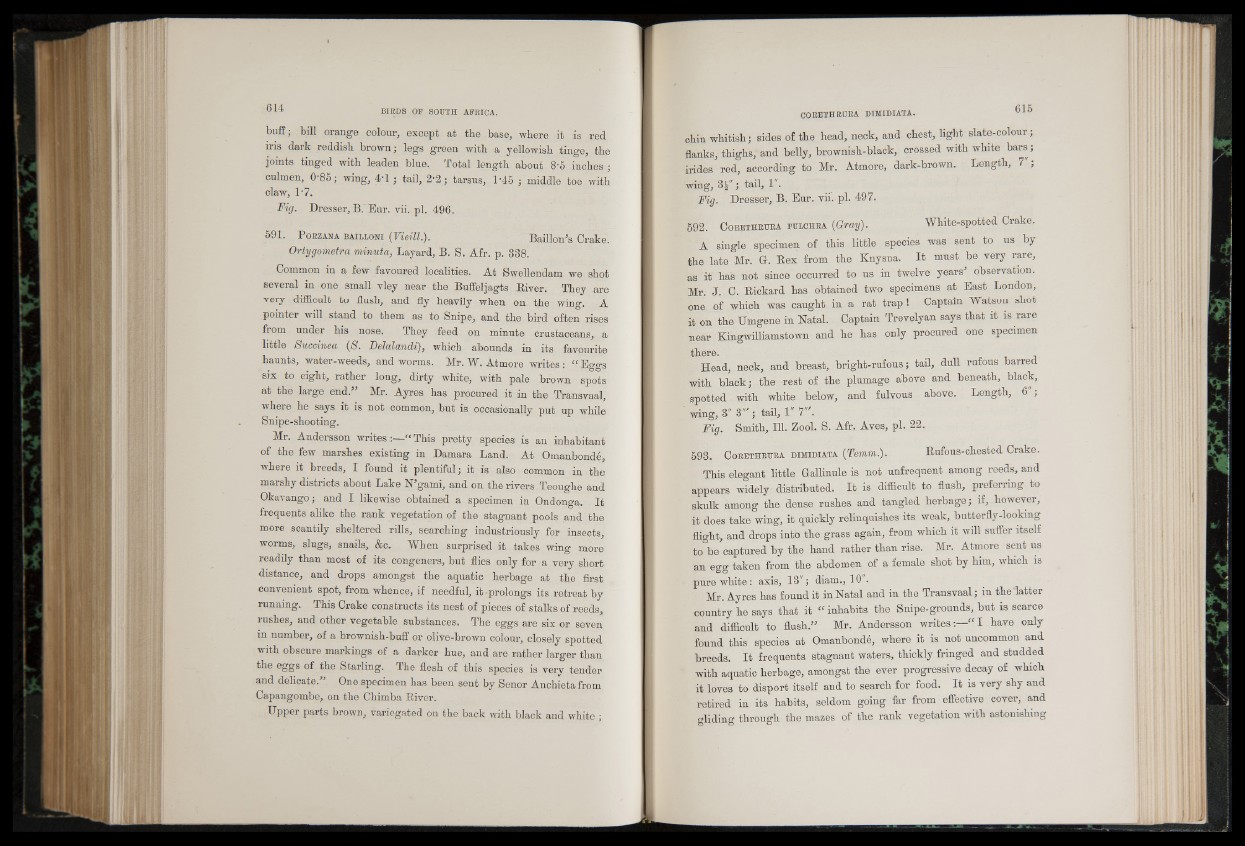
buff; bill orange colour, except at the base, where it is red
iris dark reddish brown; legs green with a yellowish .tinge, the
joints tinged with leaden blue. Total length about 8-5 inches ;
culmen, 0'85; wing, 4-1; tail, 2-2; tarsus, L45 ; middle toe with
claw, T7.
Fig. Dresser, B. Eur. vii. pi. 496.
591. P o r z a n a b a i l l o h i {Vieill.). Baillon’s Crake.
Ortygometra minuta, Layard, B. S. Afr. p. 338.
Common in a few favoured localities. At Swellendam we shot
several in one small vley near the Buffeljagts Biver. They are
very difficult to flush, and fly heavily when on the wing. A
pointer will stand to them as to Snipe, and the bird often rises
from under his nose. They feed on minute crustaceans, a
little Succinea (8 . Delalandi), which abounds in its favourite
haunts, water-weeds, and worms. Mr. W. Atmore writes : “ Ee-o-s
six to eight, rather long, dirty white, with pale brown spots
at the large end.” Mr. Ayres has procured it in the Transvaal,
where he says it is not common, but is occasionally put up while
Snipe-shooting.
Mr. Andersson writes:—“ This pretty species is an inhabitant
of the few marshes existing in Damara Land. At Omanbonde,
where it breeds, I found it plentiful; it is also common in the
marshy districts about Lake ISP garni, and on the rivers Teoughe and
Okavango; and I likewise obtained a specimen in Ondonga. It
frequents alike the rank vegetation of the stagnant pools and the
more scantily sheltered rills, searching industriously for insects,
worms, slugs, snails, &c. When surprised it takes wing more
readily than most of its congeners, but flies only for a very short
distance, and drops amongst the aquatic herbage at the first
convenient spot, from whence, if needful, it -prolongs its retreat by
running. This Crake constructs its nest of pieces of stalks of reeds,
rushes, and other vegetable substances. The eggs are six or seven
in number, of a brownish-buff or olive-brown colour, closely spotted
with obscure markings of a darker hue, and are rather larger than
the eggs of the Starling. The flesh of this species is verv tender
and delicate.” One specimen has been sent by Senor Anchieta from
Capangombe, on the Chimba River.
Upper parts brown, variegated on the back with black and white ;
chin whitish; sides of the head, neck, and chest, light slate-colour;
flanks, thighs, and belly, brownish-black, crossed with white bars;
irides red, according to Mr. Atmore, dark-brown. Length, 7 ;
wing, 3j" ; tail, 1 ".
Fig. Dresser, B. Eur. vii. ph 497.
592. C o r e th ru ra pulchra {Gray). White-spotted Crake.
A single specimen of this little species was sent to us by
the late Mr. Gr. Rex from the Knysna. I t must be very rare,
as it has not since occurred to us in twelve years’ observation.
Mr. J. C. Rickard has obtained two specimens at East London,
one of which was caught in a rat trap! Captain Watson shot
it on the Umgene in Natal. Captain Trevelyan says that it is rare
near Kingwilliamstown and he has only procured one specimen
there.
Head, neck, and breast, bright-rufous; tail, dull rafous barred
with black; the rest of the plumage above and beneath, black,
spotted with white below, and fulvous above. Length, 6 ';
wing, 3" 3"'; tail, 1" 7"'.
Fig. Smith, 111. Zool. S. Afr. Aves, pi. 22.
593. C oreth ru ra d im id ia ta (Temm.). Rufous-chested Crake.
This elegant little Gallinule is not unfrequent among reeds, and
appears widely distributed. I t is difficult to flush, preferring to
skulk among the dense rushes and tangled herbage; if, however,
it does take wing, it quickly relinquishes its weak, butterfly-looking
flight, and drops into the grass again, from which it will suffer itself
to be captured by the hand rather than rise. Mr. Atmore sent us
an egg taken from the abdomen of a female shot by him, which is
pure white : axis, 13 ; diam., 10 .
Mr. Ayres has found it in Natal and in the Transvaal; in the'latter
country he says that it “ inhabits the Snipe-grounds, but is scarce
and difficult to flush.” Mr. Andersson writes:—“ I have only
found this species at Omanbonde, where it is not uncommon and
breeds. I t frequents stagnant waters, thickly fringed and studded
with aquatic herbage, amongst the ever progressive decay of which
it loves to disport itself and to search for food. I t is very shy and
retired in its habits, seldom going far from effective cover, and
gliding through the mazes of the rank vegetation with astonishing